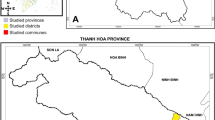Abstract
As most natural watercress beds in central France are located upstream of the permanent habitats of two lymnaeid species, Galba truncatula and Omphiscola glabra, field investigations were made from 1999 to 2004 on 67 beds to determine why the contamination of watercress with Fasciola hepatica is irregular over time in these sites, while definitive hosts, especially lagomorphs, are regularly found infected around them. Snails are able to migrate upstream in winter and spring towards the beds, and a 4-year survey demonstrated the existence of annual variation in the colonization of these sites by snails. In the 45 beds irregularly contaminated with F. hepatica over time, 37.7–62.2%, according to the year, were not populated by lymnaeids, in spite of the presence of snail populations downstream. G. truncatula was found alone in 8.8–13.3% of sites and was the first colonizing snail in 24.3–33.3% when the two lymnaeid species successively settled in these waterholes. The colonizing ability of O. glabra was more limited, as it was observed alone in 2.2% of beds and was the first colonizing snail in only 2.2–20% of them. The distances covered by these snails significantly increased with increasing migration time. After migration, a few overwintering snails (3.8% of G. truncatula and 6.8% of O. glabra) are able to colonize the beds, but their numbers decreased when the distance of migration was greater. O. glabra migrated more quickly and reached more watercress beds than G. truncatula. However, this did not influence the natural infections of snails, which were more frequent in the F1 of G. truncatula. The variability observed in the colonization of beds by snails might explain the regular or irregular contamination of wild watercress by metacercariae of F. hepatica. One of the factors which may explain this variability is the occurrence of showers in spring, so that a few snails are able to reach watercress beds after their upstream migration.
Similar content being viewed by others
References
Abrous M, Rondelaud D, Dreyfuss G, Cabaret J (1999) Infection of Lymnaea truncatula and Lymnaea glabra by Fasciola hepatica and Paramphistomum daubneyi in farms of central France. Vet Res 30:113–118
Abrous M, Rondelaud D, Dreyfuss G (2000) A field study of natural infections in three freshwater snails with Fasciola hepatica and/or Paramphistomum daubneyi in central France. J Helminthol 74:189–194
Dreyfuss G, Vignoles P, Rondelaud D (2003) Natural infections of Omphiscola glabra with Fasciola hepatica in central France. Parasitol Res 91:458–461
Gold D, Goldberg M (1979) Temperature effect on susceptibility of four species of Lymnaea snails to infection with Fasciola hepatica (Trematoda). Isr J Zool 28:163–170
Mas-Coma S, Bargues MD, Esteban JG (1998) Human fasciolosis. In: Dalton JP (ed) Fasciolosis. CABI, Oxon, pp 411–434
Rondelaud D (1980) Données épidémiologiques sur la distomatose humaine à Fasciola hepatica L. dans la région du Limousin. Les plantes consommées et les limnées vectrices. Ann Parasitol Hum Comp 55:393–405
Rondelaud D (1983) Les réseaux de drainage superficiel et leur colonisation par Lymnaea truncatula Müller. A propos de quatre années d’observations en Haute-Vienne, France. Ann Rech Vét 14:57–63
Rondelaud D (1991) Les cressonnières naturelles du Limousin et leur contamination par Fasciola hepatica L. Bilan d’une enquête de 20 années. Ann Sci Limousin 7:3–14
Rondelaud D, Dreyfuss G, Bouteille B, Dardé ML (2000) Changes in human fasciolosis in a temperate area: about some observations over a 28-year period in central France. Parasitol Res 86:755–757
Rondelaud D, Vignoles P, Abrous M, Dreyfuss G (2001) The definitive and intermediate hosts of Fasciola hepatica in the natural watercress beds in central France. Parasitol Res 87:475–478
Stat-Itcf (1988) Manuel d’utilisation. Institut technique des céréales et des fourrages, Service des études statistiques, Boigneville
Vareille-Morel C, Dreyfuss G, Rondelaud D (1999) The characteristics of habitats colonized by three species of Lymnaea in swampy meadows on acid soil: their interest for fasciolosis control. Ann Limnol 35:173–178
Author information
Authors and Affiliations
Corresponding author
Rights and permissions
About this article
Cite this article
Rondelaud, D., Hourdin, P., Vignoles, P. et al. The contamination of wild watercress with Fasciola hepatica in central France depends on the ability of several lymnaeid snails to migrate upstream towards the beds. Parasitol Res 95, 305–309 (2005). https://doi.org/10.1007/s00436-004-1283-5
Received:
Accepted:
Published:
Issue Date:
DOI: https://doi.org/10.1007/s00436-004-1283-5




